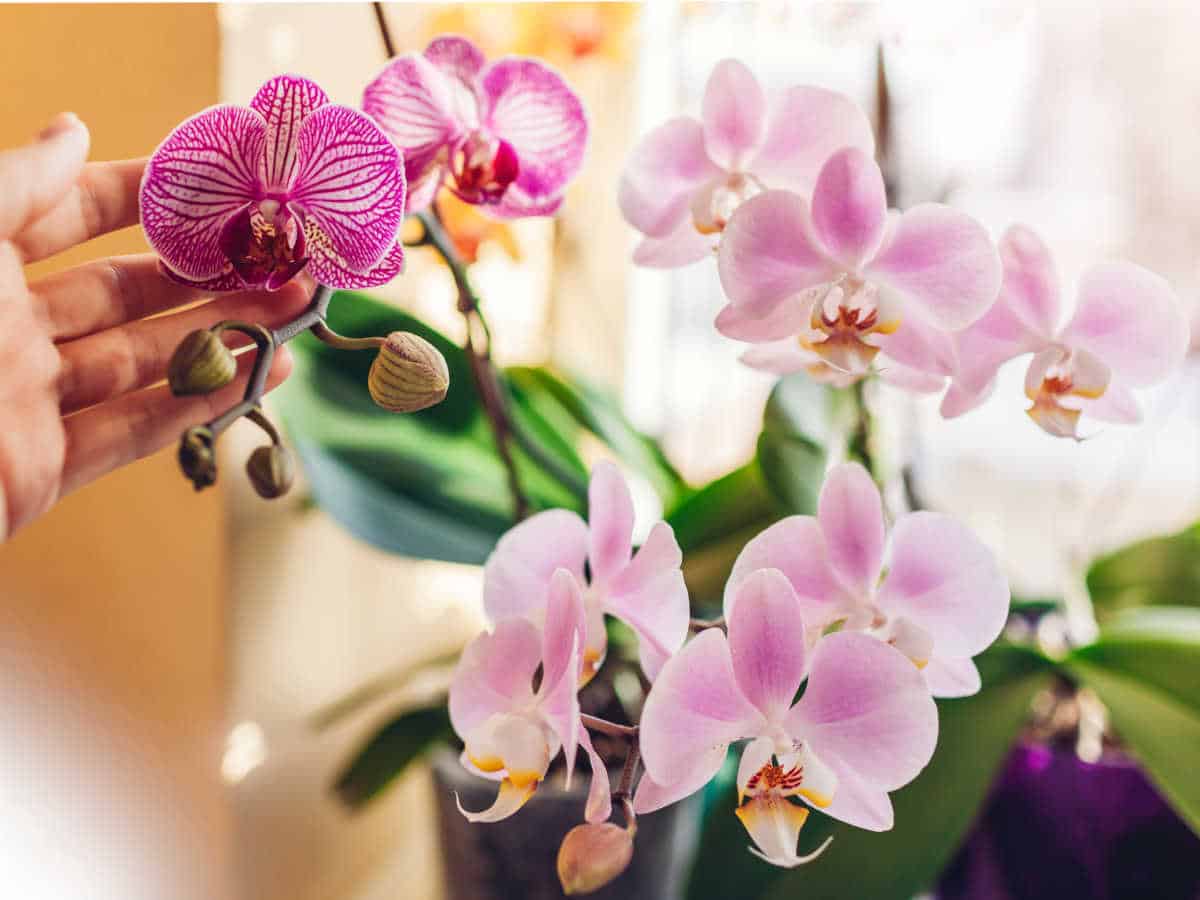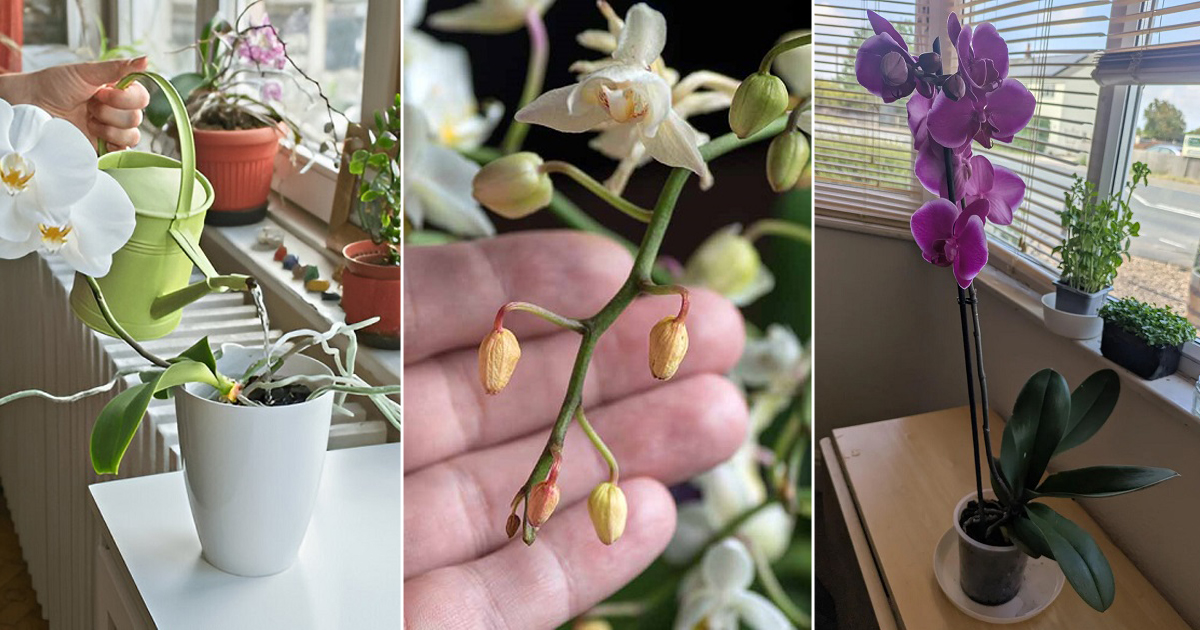When Anticipation Turns into Disappointment
At DH Garden Centre in Vancouver, I’ve seen it happen more times than I can count.
A customer walks in, holding an orchid that looked like it was about to bloom but instead of opening into elegant flowers, the buds have turned yellow, shriveled, and dropped off. It’s frustrating. It’s disheartening. And it feels like something went wrong even though you followed all the “basic” care tips.
This condition is called bud blast, and it’s more common than most people realize – especially here in Canada where temperature swings and dry indoor air can really stress these tropical beauties. But here’s the good news: bud blast isn’t a mystery. It’s your orchid’s way of telling you, “I’m stressed.” And once you understand what stresses them out, you can prevent it and enjoy the full bloom you’ve been waiting for.
Let’s dive deep into why bud blast happens, and more importantly, how you can stop it from happening again.

This condition is called bud blast, and it’s more common than most people realize especially here in Canada where temperature swings and dry indoor air can really stress these tropical beauties.
What Is Bud Blast in Orchids?
Bud blast refers to the premature failure of orchid flower buds. You’ll see buds that were developing well suddenly:
-
Turn yellow or brown
-
Dry out
-
Fall off the stem before opening
Your orchid’s leaves may look lush, and the roots might appear healthy and firm yet the flower buds begin to turn yellow, shrivel up, and fall off before they ever bloom. This frustrating condition is known as orchid bud blast, and it’s often the result of subtle environmental stress that many growers don’t immediately notice.
Phalaenopsis orchids—the most commonly grown type in homes across Canada are particularly prone to bud blast, but this issue can also affect Dendrobium orchids, Oncidiums, Cattleyas, and more. Whether you’re growing orchids on a sunny windowsill in Vancouver or under grow lights indoors, bud drop is a signal that something in the environment has shifted, causing the plant to abort its blooming process.
Understanding why orchid buds fall off before opening is the first step to preventing it. Whether it’s a drop in humidity, temperature swings, or even invisible gases like ethylene from nearby fruit, orchids are sensitive. And when their environment changes too quickly or becomes unsuitable, they respond by sacrificing the most delicate part of their system—their flower buds.

Phalaenopsis orchids the most commonly grown type in homes across Canada are particularly prone to bud blast, but this issue can also affect Dendrobium orchids, Oncidiums, Cattleyas, and more.
The Top 5 Causes of Orchid Bud Blast
1. Sudden Temperature Fluctuations
Orchids are tropical plants. They thrive in environments where temperatures remain stable, both day and night. Here in Vancouver, that’s not always easy—especially during fall, winter, or when heating systems switch on and off.
Common mistakes:
-
Placing your orchid near a cold window at night
-
Letting it sit close to a heater or fireplace
-
Moving it from a warm room to a chilly one
-
Transporting it in a cold car during winter months
These abrupt changes confuse the orchid and cause it to abandon flowering.
Ideal conditions:
-
Day: 65–75°F (18–24°C)
-
Night: slightly cooler, but no sudden drops below 55°F (13°C)
2. Low Indoor Humidity
Orchids like it humid—50–70% humidity is ideal. But inside most Canadian homes, especially in winter, humidity can plummet below 30%.
This dry air pulls moisture from the delicate flower buds faster than the plant can supply it.
What makes it worse?
-
Indoor heating
-
Air conditioning
-
Constant airflow from fans or vents
3. Lighting That Changes Too Fast
Orchids are creatures of habit. Sudden changes in light exposure can confuse and stress the plant.
Problems occur when:
-
You move your orchid from a bright spot to a dark corner
-
Or from indirect light to direct sun, which can scorch the leaves
-
Or if you suddenly start using grow lights inconsistently
Best practice: Keep them in bright, indirect light—like an east- or north-facing window. If using grow lights, keep the schedule consistent: 12–14 hours per day.
4. Improper Watering
Orchids are picky about water.
-
Too little water? Roots dry out and can’t hydrate the buds.
-
Too much water? Roots rot and can’t support the plant.
Both lead to stress. And since flower buds are the most sensitive part of the plant—they’re the first to go.
Watch for:
-
Silvery-gray roots = time to water
-
Mushy, brown roots = overwatered
At DH Garden Centre, I always tell customers: “Water deeply, but infrequently. And always let the pot drain completely.”
5. Ethylene Gas from Fruit
This one shocks most people:
Did you know that ripening fruit gives off a gas called ethylene—and orchids are extremely sensitive to it?
A single banana on the windowsill near your orchid could cause it to drop its buds overnight.
Even fruit compost bins nearby can be a problem.
How to Prevent Orchid Bud Blast
Now that we’ve identified the culprits, here’s how to protect your orchid from bud blast and enjoy a long, beautiful bloom period.
✔️ Maintain a Consistent Temperature
Avoid:
-
Placing orchids near cold windows
-
Hot radiators or floor vents
-
Frequently opened exterior doors
Instead:
-
Use a thermometer to monitor room temperature
-
Keep orchids in a spot with stable temperatures between 18–24°C
If transporting your orchid during winter, wrap it gently with a towel to protect it from drafts.
✔️ Raise Humidity the Right Way
Simple methods to increase humidity:
-
Humidity trays: Place pebbles in a shallow tray, add water, and set your orchid pot on top (not in the water)
-
Group your plants: Plants release moisture into the air, so placing them together creates a humid microclimate
-
Mist in the morning: Light misting helps, but avoid soaking buds directly
At DH Garden Centre, we carry orchid humidity trays and gentle misters perfect for indoor use.

At DH Garden Centre, we carry orchid humidity trays and gentle misters perfect for indoor use.
✔️ Keep Lighting Gentle and Consistent
Your orchid loves routine. Choose a bright but filtered light spot—and stick to it.
-
North-facing or east-facing windows are ideal
-
Use sheer curtains to diffuse light
-
If using artificial lights, maintain a regular schedule
Avoid moving your orchid around the house too often. Let it settle in and adapt.
✔️ Master the Art of Orchid Watering
-
Use room temperature water
-
Water once a week, or when roots are silvery
-
Let water flow through the pot and drain completely
-
Never let the pot sit in standing water
-
Avoid watering late in the evening (to prevent overnight moisture buildup)
If you’re unsure about timing, I recommend lifting the pot—if it feels very light, it’s likely ready for watering.
✔️ Remove Fruit from the Area
Keep orchids away from:
-
Fruit bowls (especially bananas, apples, avocados)
-
Compost bins or fruit scraps
-
Kitchen counters with ripening produce
If you notice bud blast and your orchid sits near a fruit bowl this may be your answer.
Frequently Asked Questions
❓ Will My Orchid Bloom Again After Bud Blast?
Yes, most healthy orchids will rebloom during their next cycle. Focus on stabilizing the environment, and your plant should try again in a few months.
❓ Can I Still Fertilize an Orchid That Lost Its Buds?
Yes, but be gentle. Use a balanced orchid fertilizer (like 20-20-20) at half strength once a month. Do not over-fertilize—especially after bud drop.
❓ Should I Cut Off the Flower Spike After Bud Blast?
If the spike is still green and healthy, leave it. Your orchid might rebloom from a node. If it turns brown and dry, cut it back to the base.
❓ Can Bud Blast Spread to Other Orchids?
Bud blast itself isn’t contagious—it’s a stress reaction. But if one orchid is stressed, it may indicate environmental conditions (like dry air or gas exposure) that could affect nearby plants too.
Final Thought: Orchids Just Want Peace and Consistency
If you take one message from this guide, let it be this:
🌸 Orchids don’t like surprises.
They want stable temperatures, gentle light, steady watering, and no unexpected stress.
At DH Garden Centre, we often tell customers: “When your orchid feels safe, it will bloom.”
If your buds dropped off, don’t give up. You didn’t fail. You just hit a bump in the road. Adjust the conditions, be patient, and your orchid will reward you with blooms that are not just beautiful but magical.
Need help diagnosing your plant?
📍 Come visit us at 3742 West 10th Avenue, Vancouver, BC
📷 Bring a photo, and we’ll guide you to your next bloom.
Together, let’s bring the beauty back to your orchid.


